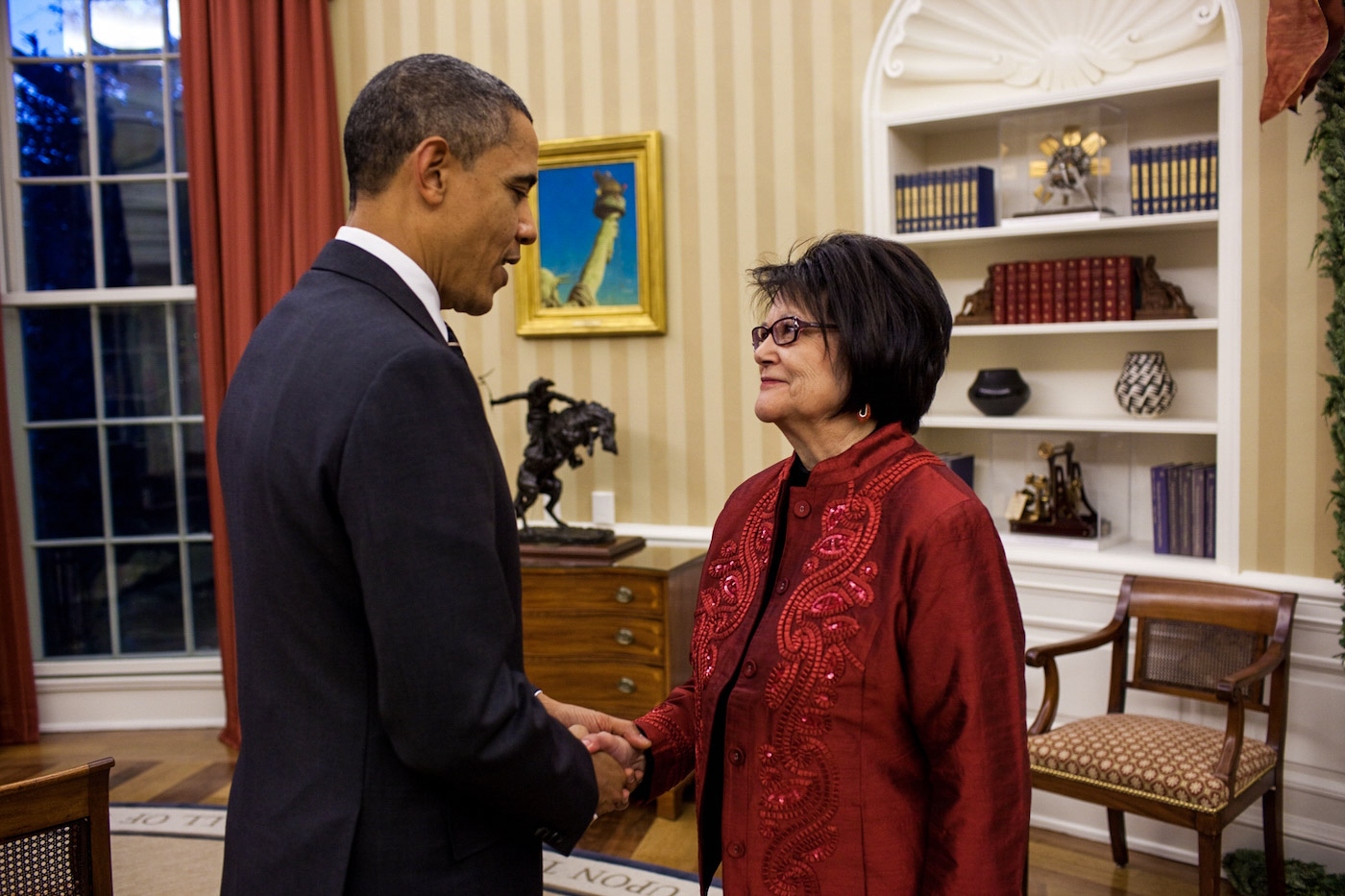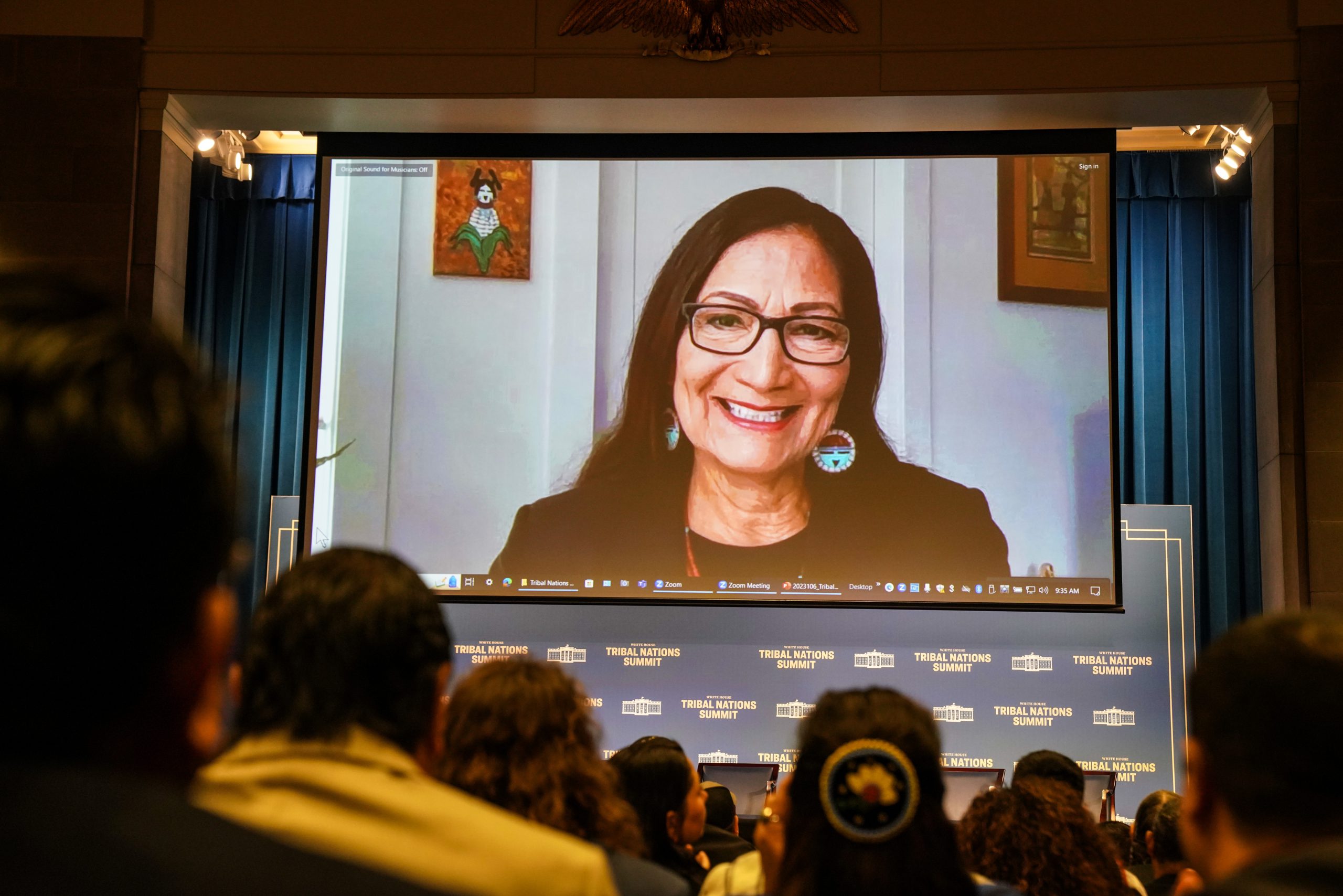Indianz.Com > News > Land consolidation back on the agenda for Indian Country
Land consolidation back on the agenda for Indian Country
Thursday, January 25, 2024
Indianz.Com
After 10 years and more than $1.6 billion put in the hands of Indian Country, a successful program that was designed to address a harmful era in federal policy has finally come to a close.
On the eve of the White House Tribal Nations Summit last month, the Department of the Interior announced the conclusion of the Land Buy-Back Program for Tribal Nations.
A final report hailed the “unprecedented scale” of an initiative that returned nearly 3 million acres of land in 15 states to tribal ownership.
“Assimilation policies not only attempted to break apart Indigenous families, devastate ecosystems and eliminate Native languages, they also worked to weaken land claims and tribal land ownership,” Secretary Deb Haaland, who is the first Native person to lead the federal agency with the most trust and treaty responsibilities in Indian Country, said in a December 4 news release. “The checkerboard system of land ownership on many reservations historically left communities and landowners unable to make basic decisions about their homelands.”
“The Land Buy-Back Program’s progress puts the power back in the hands of tribal communities to determine how their lands are used — from conservation to economic development projects,” said Halaand, a citizen of the Pueblo of Laguna.

According to Interior, the Land Buy-Back Program for Tribal Nations has helped address fractionation by acquiring nearly 1.1 million in fractional interests from individual Indians. These owners were paid $1.69 billion for their lands, the department’s final report stated. Tribes also have benefited, the department said. The restoration of 2.97 million acres to tribal ownership has resulted in more funds flowing into tribal trust accounts and the creation of more than 20,000 jobs in Indian Country, according to the report. “Reducing fractionation and achieving tribal majority ownership provides for more efficient trust management through simplified leasing processes that uphold tribal sovereignty, self-determination, and the government-to-government relationship,” said Assistant Secretary for Indian Affairs Bryan Newland, a political appointee who oversees the BIA. “Land consolidation partnerships with tribal nations benefit both landowners and tribes, including opportunities for increased agricultural operations, economic development, conservation, and cultural stewardship,” said Newland, a citizen of the Bay Mills Indian Community. “The lessons learned from the Buy-Back Program will help inform our ongoing efforts to reduce fractionation.”The progress @Interior made through the Land Buy-Back Program puts power in the hands of Tribal communities to determine how their lands are used — allowing for Tribally-led conservation, economic development and a restoration of Tribal homelands. https://t.co/FSmGmENyH9
— Secretary Deb Haaland (@SecDebHaaland) December 4, 2023
Budget Justification: Indian Land Consolidation – PDF
The Biden administration is hoping to continue the lessons learned since 2012, when the Cobell program began. The BIA’s fiscal year 2024 budget, which has not formally been approved by the U.S. Congress due to ongoing disagreements among lawmakers, calls for $30.5 million to re-establish land consolidation in Indian Country.
“This program is especially important since the Land Buy-Back Program for Tribal Nations (LBBP), established as part of the Cobell Settlement, ended in November 2022,” the BIA’s budget justification reads.
But not all lawmakers are on board. Rep. Harriet Hageman (R-Wyoming), a key Republican who chairs the House Subcommittee on Indian and Insular Affairs, questioned the request for new funds at one of her first hearings as a new member of Congress.
“Throwing more money at the complicated issue of land fractionation will not get us anywhere without reconsidering how to deal with the issue of probate and focusing resources on
how to pursue outcomes on this issue that are the very best for
our tribes,” Hageman said at a subcommittee hearing on May 25, 2023.
In contrast, Rep. Teresa Leger Fernandez (D-New Mexico), who chaired the predecessor subcommittee when Democrats controlled the U.S. House of Representatives, spoke in support of the budget request.
“That is what we need to have happen, because what we have presented here are key increases for initiatives,” Leger Fernandez said of several programs at the BIA, including land consolidation.
Hageman and Leger Fernandez will get another chance to examine the issue next week. The subcommittee has scheduled a January 30 hearing to address the “opportunities and challenges” of land consolidation. A witness list has not yet been made public.
But the BIA already acknowledges that the successes of the Cobell program will be undermined without additional funds. At the hearing last year, Assistant Secretary Newland warned that land will continue to fall out of Indian hands unless the federal government takes action. “If we don’t continue these investments, land will go out of trust through the fractionation process, and by 2038 more land will be fractionated in Indian Country than when we started the Cobell settlement,” Newland said after Hageman asked about the $30.5 million request in the BIA’s budget. According to Interior’s final report, 53 tribes participated in the Land Buy-Back Program. Almost all of them entered into cooperative agreements with the federal government, helping to facilitate land acquisitions and encourage participation among individual Indians. The Cobell settlement allowed the BIA to use up to 15 percent of the $1.9 billion in land consolidation funds for administrative purposes, such as developing agreements with tribes, engaging in outreach and conducting evaluations of fractional interests. But the agency only used $149.8 million, resulting in more money being put into land sales, the report stated.The Cobell Settlement closed a dark chapter in our history, and paved the way for a stronger relationship between Indian country and the Department.
— Bryan Newland (@AsstSecNewland) December 4, 2023
As a result of that settlement, we’ve worked with Tribes to restore 3 million acres of land to tribal ownership. https://t.co/nuGinXqDE6

Sales Data: Land Buy-Back Program for Tribal Nations – PDF
land-buy-back-program-for-tribal-nations-cumulative-sales-through-november-25-2022
House Subcommittee on Indian and Insular Affairs Notice
Examining the Opportunities and Challenges of Land Consolidation in Indian Country (January 30, 2024)
Search
Filed Under
Tags
More Headlines
Press Release: National Museum of the American Indian hosts Native art market
AUDIO: Sea Lion Predation in the Pacific Northwest
Native America Calling: Tribal colleges see an uncertain federal funding road ahead
Native America Calling: Short films taking on big stories
Native America Calling: Advocates push back against new obstacles to Missing and Murdered Indigenous Relatives momentum
Native America Calling: For all its promise, AI is a potential threat to culture
NAFOA: 5 Things You Need to Know this Week (November 24, 2025)
Chuck Hoskin: Cherokee Nation invests in rural transportation
Native America Calling: Native candidates make strides in local elections
National Congress of American Indians returns incumbents and welcomes newcomers to leadership
National Congress of American Indians chooses leadership at big convention
‘Not voting is still a vote’: Native turnout drops amid changes in political winds
Native America Calling: Indigenous voices speak up, but have little clout at COP30
‘It’s bull****’: Indian Country confronts challenges at largest inter-tribal conference
Native America Calling: The constant burden on tribal hunters to justify their treaty rights
More Headlines
AUDIO: Sea Lion Predation in the Pacific Northwest
Native America Calling: Tribal colleges see an uncertain federal funding road ahead
Native America Calling: Short films taking on big stories
Native America Calling: Advocates push back against new obstacles to Missing and Murdered Indigenous Relatives momentum
Native America Calling: For all its promise, AI is a potential threat to culture
NAFOA: 5 Things You Need to Know this Week (November 24, 2025)
Chuck Hoskin: Cherokee Nation invests in rural transportation
Native America Calling: Native candidates make strides in local elections
National Congress of American Indians returns incumbents and welcomes newcomers to leadership
National Congress of American Indians chooses leadership at big convention
‘Not voting is still a vote’: Native turnout drops amid changes in political winds
Native America Calling: Indigenous voices speak up, but have little clout at COP30
‘It’s bull****’: Indian Country confronts challenges at largest inter-tribal conference
Native America Calling: The constant burden on tribal hunters to justify their treaty rights
More Headlines